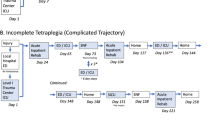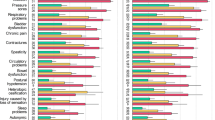Abstract
Study design
Qualitative study using semi-structured interviews.
Objectives
To describe and compare models of service delivery intended to support community integration in the immediate period following inpatient rehabilitation for SCI, and describe the characteristics of these models or approaches.
Setting
Spinal services from multiple international countries
Methods
Semi-structured interviews were completed with 12 participants from a convenience sample of ten spinal services from developed economies. Interviews were audio-recorded, transcribed verbatim and thematically analysed.
Results
Three themes were identified, and are described with supporting quotations. These are: Theme One—Models of service delivery (sub-themes: staffing, peer mentors, facilitating community integration during inpatient rehabilitation; Theme Two—Services provided (sub-themes: telehealth, vocational services, groups); Theme Three—Facilitating self-efficacy and self-management.
Conclusions
A variety of models aimed at supporting community integration in the immediate period following inpatient rehabilitation for SCI were found. Multi-disciplinary staffing and involvement of peer mentors was common to all services. The importance of vocational rehabilitation was acknowledged by all participants, although the approaches taken to this varied. Telehealth has the potential to assist in self-management, particularly for patients who live a long distance from the spinal unit or are confined to the home for health reasons, and could be further developed. Although service models are greatly influenced by the funding context, the findings from this study can be used to inform service planning in this area.
Similar content being viewed by others
Log in or create a free account to read this content
Gain free access to this article, as well as selected content from this journal and more on nature.com
or
Data availability
Interview transcripts are available on request.
References
Dwyer KJ, Mulligan H. Community reintegration following spinal cord injury: insights for health professionals in community rehabilitation services in New Zealand. NZ J Physiother. 2015;43:75–85.
Whiteneck G, Meade MA, Dijkers M, Tate DG, Busnik T, Forchheimer MB. Environmental factors and their role in participation and life satisfaction after spinal cord injury. Arch Phys Med Rehabilit. 2004;85:1793–803.
Chang F-H, Coster WJ, Helfrich CA. Community participation measures for people with disabilities: systematic review of content from an International Classification of Functioning, Disability and Health Perspective. Arch Phys Med Rehabilit. 2013;94:771–81.
Craig A, Nicholson Perry K, Guest R, Tran Y, Middleton J. Adjustment following chronic spinal cord injury: determining factors that contribute to social participation. Br J Health Psychol. 2015;20:807–23.
Barclay L, McDonald R, Lentin P, Bourke-Taylor H. Facilitators and barriers to social and community participation following spinal cord injury. Aust Occup Ther J. 2016;63:19–28.
Whiteneck G, Gassaway J, Marcel P, Lammertse D, Hammond F. Inpatient and postdischarge rehabilitation services provided in the first year after spinal cord injury: findings from the SCIRehab study. Arch Phys Med Rehabilit. 2011;92:361–8.
New PW. Prospective study of barriers to discharge from a spinal cord injury rehabilitation unit. Spinal Cord. 2014;53:358.
Delparte JJ, Chau BA, Mills S, Burns AS. Spinal cord essentials: the development of an individualized, handout-based patient and family education initiative for people with spinal cord injury. Spinal Cord. 2014;52:400–6.
Burns AS, Yee J, Flett HM, Guy K, Cournoyea N. Impact of benchmarking and clinical decision making tools on rehabilitation length of stay following spinal cord injury. Spinal Cord. 2012;51:165.
Kennedy P, Sherlock O, McClelland M, Short D, Royle J, Wilson C. A multi-centre study of the community needs of people with spinal cord injuries: the first 18 months. Spinal Cord. 2010;48:15–20.
Management of People with Spinal Cord Injury NHS Clinical Advisory Groups Report. NHS Clinical Advisory Groups Report on Regional Networks for Major Trauma (September 2010). 2011. https://www.mascip.co.uk/wp-content/uploads/2015/03/Management-of-People-with-SCI.-NHS-CAG-Report.pdf.
Cox RJ, Amsters DI, Pershouse KJ. The need for a multidisciplinary outreach service for people with spinal cord injury living in the community. Clin Rehabilit. 2001;15:600–6.
Creswell J. Qualitative enquiry and research design: choosing among five approaches. 3rd ed. Los Angeles: Sage; 2013.
Tong A, Sainsbury P, Craig J. Consolidated criteria fore reporting qualitative research (COREQ): a 32-item checklistfor interviews and focus groups. Int J Qual Health Care. 2007;19:349–57.
Braun V, Clarke V. Successful qualitative research: a practical guide for beginners. London: Sage Publications Ltd; 2013.
Block P, Vanner EA, Keys CB, Rimmer JH, Skeels SE. Project Shake-It-Up: using health promotion, capacity building and a disability studies framework to increase self efficacy. Disabil Rehabilit. 2010;32:741–54.
Byrnes M, Beilby J, Ray P, McLennan R, Ker J, Schug S. Patient-focused goal planning process and outcome after spinal cord injury rehabilitation: quantitative and qualitative audit. Clin Rehabilit. 2012;26:1141–9.
Wallace MA, Kendall MB. Transitional rehabilitation goals for people with spinal cord injury: looking beyond the hospital walls. Disabil Rehabilit. 2014;36:642–50.
Gassaway J, Jones ML, Sweatman WM, Hong M, Anziano P, DeVault K. Effects of peer mentoring on self-efficacy and hospital readmission after inpatient rehabilitation of individuals with spinal cord injury: a randomized controlled trial. Arch Phys Med Rehabilit. 2017;98:1526–34. e2
Momsen AM, Rasmussen JO, Nielsen CV, Iversen MD, Lund H. Multidisciplinary team care in rehabilitation: an overview of reviews. J Rehabilit Med. 2012;44:901–12.
Kennedy P, Lude P, Taylor N. Quality of life, social participation, appraisals and coping post spinal cord injury: a review of four community samples. Spinal Cord. 2006;44:95–105.
Hoffman JM, Bombardier CH, Graves DE, Kalpakjian CZ, Krause JS. A longitudinal study of depression from 1 to 5 years after spinal cord injury. Arch Phys Med Rehabilit. 2011;92:411–8.
Migliorini C, Tonge B, Taleporos G. Spinal cord injury and mental health. Aust NZ J Psychiatry. 2008;42:309–14.
Barclay L, Hilton GM. A scoping review of peer-led interventions following spinal cord injury. Spinal Cord. 2019;57:626–635.
Shem K, Medel R, Wright J, Kolakowsky-Hayner SA, Duong T. Return to work and school: a model mentoring program for youth and young adults with spinal cord injury. Spinal Cord. 2011;49:544–8.
Zinman A, Digout N, Bain P, Haycock S, Hébert D, Hitzig SL. Evaluation of a community reintegration outpatient program service for community-dwelling persons with spinal cord injury. Rehabilit Res Pract. 2014. https://doi.org/10.1155/2014/989025.
Coker J, Charlifue S, Huey SK. Reinventing yourself after spinal cord injury: a bridge from rehabilitation to real world. Poster. 56th Annual Scientific Meeting. Ireland: International Spinal Cord Society. Dublin; 2017.
Woo C, Guihan M, Frick C, Gill CM, Ho CH. What's happening now! Telehealth management of spinal cord injury/disorders. J Spinal Cord Med. 2011;34:322–31.
Sanford JA, Griffiths PC, Richardson P, Hargraves K, Butterfield T, Hoenig H. The effects of in-home rehabilitation on task self-efficacy in mobility-impaired adults: a randomized clinical trial. J Am Geriatrics Soc. 2006;54:1641–8.
Munce SE, Fehlings MG, Straus SE, Nugaeva N, Jang E, Webster F, et al. Views of people with traumatic spinal cord injury about the components of self-management programs and program delivery: a Canadian pilot study. BMC Neurol. 2014;14:209.
Ullah MM, Fossey E, Stuckey R. The meaning of work after spinal cord injury: a scoping review. Spinal Cord. 2018;56:92–105.
Hilton G, Unsworth C, Murphy G, Browne M, Olver J. Longitudinal employment outcomes of an early intervention vocational rehabilitation service for people admitted to rehabilitation with a traumatic spinal cord injury. Spinal Cord. 2017;55:743–52.
Acknowledgements
We acknowledge the Transport Accident Commission, Victoria, Australia, for their support in conducting this study.
Funding
This study was supported by funding from the Transport Accident Commission, Victoria, Australia (Grant number: T008).
Author information
Authors and Affiliations
Contributions
LB was responsible for designing the study, conducting the interviews, analysing the data, and writing the manuscript. The remaining three authors were responsible for analysing the data and contributing to writing the manuscript. In addition, AL conducted some of the interviews.
Corresponding author
Ethics declarations
Conflict of interest
The authors declare that they have no conflict of interest.
Ethical approval
We certify that all applicable institutional and governmental regulations were followed during the course of this research.
Additional information
Publisher’s note Springer Nature remains neutral with regard to jurisdictional claims in published maps and institutional affiliations.
Rights and permissions
About this article
Cite this article
Barclay, L., Lalor, A., Migliorini, C. et al. A comparative examination of models of service delivery intended to support community integration in the immediate period following inpatient rehabilitation for spinal cord injury. Spinal Cord 58, 528–536 (2020). https://doi.org/10.1038/s41393-019-0394-x
Received:
Revised:
Accepted:
Published:
Issue date:
DOI: https://doi.org/10.1038/s41393-019-0394-x
This article is cited by
-
Current Approaches in Telehealth and Telerehabilitation for Spinal Cord Injury (TeleSCI)
Current Physical Medicine and Rehabilitation Reports (2022)
-
Understanding how a community-based intervention for people with spinal cord injury in Bangladesh was delivered as part of a randomised controlled trial: a process evaluation
Spinal Cord (2020)
-
Return to work after spinal cord injury: a Singaporean pilot community-based rehabilitation program
Spinal Cord (2020)
-
Experiences with and perspectives on goal setting in spinal cord injury rehabilitation: a systematic review of qualitative studies
Spinal Cord (2020)



